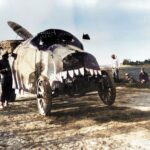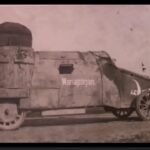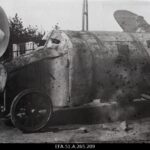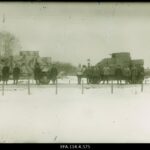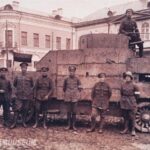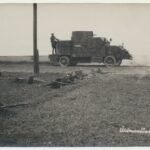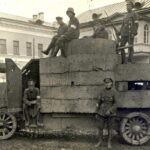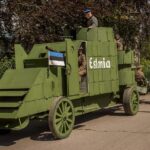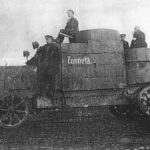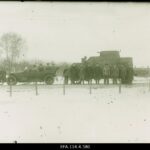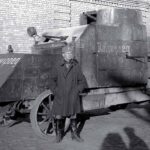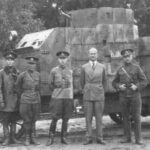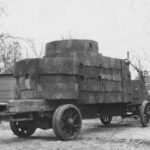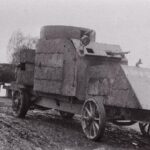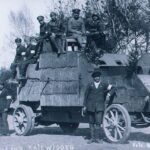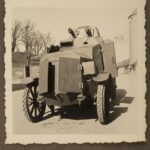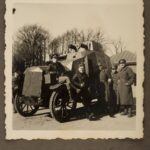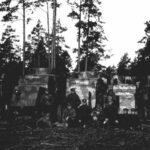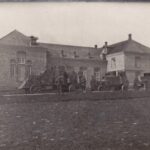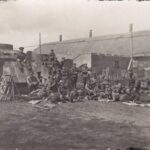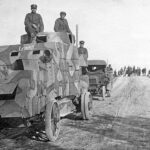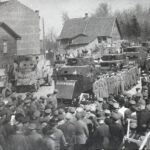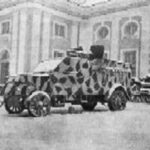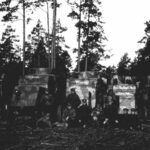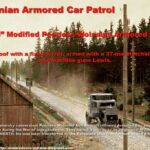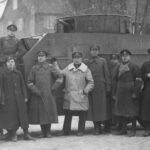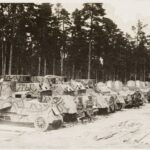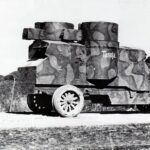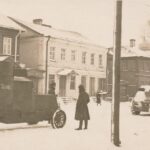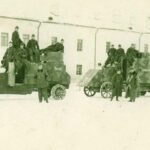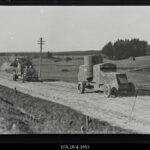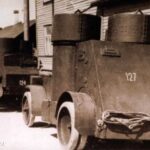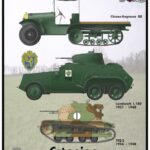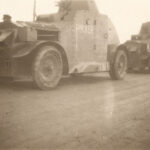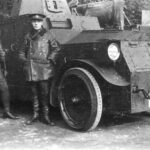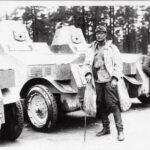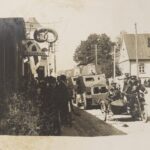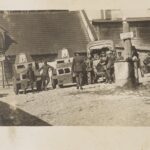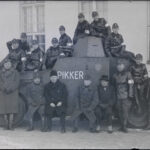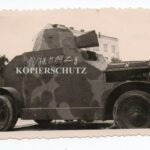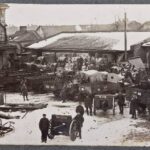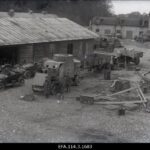I- Estonian built armored cars :
Vanapagan armored car :
Vana pagan (« Old Devil ») or rather « old pagan » is a hero of Estonian folklore. In Estonian pagan folklore, there are many legends describing natural objects and their features, as traces of the struggle of the giant Kalevipoeg with a dark giant; with the advent of Christianity, the pagan giant and the Christian demon merged into one – Vanapagan, who lives on his farm with his wife , children, workers and maids. Vanapagana is more stupid than evil, and is easily deceived by quick-witted Estonians, such as his employee Kaval-Ants (Cunning Ant).
Vanapagan armored car was built in Pärnu from January 1919 by the organization of the Pärnu department of the voluntary aid organization Ühistöo according to the design of engineer J. Jäärats on the chassis of a Delahaye truck. 7-mm. The work was carried out in a narrow-gauge railway repair shop. Iron plates were installed on a wooden frame (apparently not metal). Locomotive boilers elements with cut-out loopholes may have been used as the main elements of the armored hull. The rear part of the fighting compartment was probably the smoke box of a locomotive boiler and loopholes were cut around. The car was initially armed with two Lewis light machine gun used simply by hand through the loopholes without permanent installations, There were two more loopholes on the sides for flanking fire. A Maxim machine gun was added later. « The Old Devil » was partly built by and with the funds of the 6th Infantry Regiment of the 3rd Infantry Division. The headquarters knew nothing about it until it was used on the battlefield. It was commanded by Captain Pyotr Feofanov, commander of the machine gunners’ detachment of the 6th Infantry Regiment. The technical miracle became so heavy that it was only suitable for driving on good roads. Due to its lack of maneuverability, it could only go into battle with its rear end forward, so that it could flee quickly in case of trouble. This weapon of war arrived at the front on February 27 and was christened the Old Pagan. Similarly. Later, the front end of the car was painted with the head of the Devil with a bloody mouth, fangs, ears and horns. Vanapagan made the first fire test on March 1, 1919 near Ruhja. It took part in battles in Southern Estonia and Latvia.
It is most likely that the truck used was a Delahaye Type 53C, weighing 2.5 tons. There are several versions of how this vehicle appeared among the Estonians in the winter of 1918-1919:
– from retreating German troops, by request or by force,
– two abandoned trucks were found in a ditch, from which one working vehicle was assembled.
The Delahaye truck could have been:
– built under license in Germany and used by the German army,
– previously owned by the Russian army, then captured by the Germans and finally fell into the hands of the Estonians.
– these were trucks built under license in the German Empire and abandoned by German troops, or became trophies of the Russian army, and later also abandoned.
Some Estonian historians believe that this armored car survived until the country joined the USSR and the integration of the Estonian armed forces into the Red Army, after which it was sent along with other armored cars to storage warehouses.
Other Estonian built armored cars :
The first Estonian armored car was built in December 1918 in Tallinn Harbor factory under supervision of the engineer Lembit Saukas and by order of Johan Pitka (Chairman of the Estonian Defence League and later rear admiral and commander of Estonian Navy). It was named Estonia. It was built on a Federal Motor Truck Company 3-ton truck chassis on which a body was built consisting of a frame of angle iron to which warship armored plates were riveted. Estonia was ready on Christmas eve 1918 and was immediately sent to the front. Unfortunately, it quickly prooved ineffective because it was underpowered and too heavy for winter roads. It was thus rapidly sent back to Tallinn under the Estonia theatre Defense League unit. Estonia was rebuilt in early April 1919.
The second armored car named Tasuja was build soon after on a Renault truck chassis with an armored open top box. Building Estonia proved effective because lessons were learned, thus, Tasuja was lighter because it was built on a wooden frame rather than metal and used 6 mm trench armor plates. Tasuja was sent to Viljandi on January 13, 1919, and arrived at the front on January 20. The first battle went on January 22 in the Tõrva region in Helme. Tasuja participated in the battles in South Estonia and was lost in combat on March 23, 1919 near Orava mansion in Southern Estonia. Tasuja had to be abandoned under enemy fire because its weight collapsed a small bridge causing it to become stuck. Later a new armored car (Austin Putilov) carried the same name.
Then, Captain A. Uus was put in charge of building armored vehicles for Estonian Army. With engineer Saukas they designed new armored cars. The lessons learned from the first two cars were applied and standard design concepts were followed. The Tallinn shipyard built the armored frames on various chassis (mainly 3-ton AEC) under the direction of master boilermaker Georg Drevsi. The completed armored hulls were painted white and grey for winter and repainted olive green for summer. In December 1919 they were repainted grey-white-green or solid grey. They were lettered on both sides with the designated name of the armored car. All of them had the same organisation : the engine compartment was in front, then the driver’s compartment and at last the fighting compartment. They had one or two searchlights (headlights) in front. For firing, there were portholes on the sides of the fighting compartment, two semi-circular casemates in the back for machine guns and a turret on top with gun or machine gun. Each car had assigned a second vehicle as a tender which carried additional ammunition and other support material. A total of seven armored cars were built during January 1919. – . January 1920. All armored cars were almost similarly build and armed.
Wahur was completed in February 1919. Build on a 3-ton Packard lorry chassis and in active duty on March15, 1919.
Estonia was rebuild in April 1919, after rebuilding, it looked similar to others armored cars.
Toonela was completed in April 1919. Build on an AEC lorry chassis and in active duty on April 22, 1919.
Wibuane was completed in April 1919. Build on an AEC lorry chassis and in active duty on April 23, 1919.
Kalevipoeg was completed in April 1919. Build on an AEC lorry chassis and in active duty on April 25, 1919. Kalevipoeg was rebuilt end of the 30s.
Kotkasilm was completed in January 1920. Build on an AEC lorry chassis.
Erilane was completed in January 1920. Build on an AEC lorry chassis and later renamed Lembit.
All were armed with a 37 mm Hotchkiss automatic gun in turret, 2 X 7,62 mm Maxim machine guns in the rear and one 7,7 mm Madsen machine gun in the front. Different kinds of weapons were tested on the armored cars – the car Wibuane received a German 76 mm mortar which was fired through an opening in the roof. The mortar proved not to be very effective and the Wibuane was re-equipped with the original armament. Personal weapons for the crew consisted of pistols for the officers and rifles for the enlisted men. Measurements were slightly different because of the various chassis. Their length was from 7,6 to 8 m, their width from 2,1 to 2,4 m and their height from 2.9 to 3 m. The armored cars weighed about 7 tons and fully equipped for battle, they weighed from 8 to 8.6 tons. Initially the engines were not covered with armor but as it was realized that this critical area was vulnerable, the cars were equipped with a detachable armored engine cover. The armored car Wahur was powered by a water-cooled, four-cylinder 30 horsepower engine, the other armored cars had 40 horsepower engines and from some sources, the Kalewipoja reportedly had a 60-horsepower engine. The cars were started manually using cranks. The gearbox had four speeds forward and one reverse. The 40 horsepower engines had a fuel consumption of 90-100 liters per 100 km – the cars had a 130-liter fuel tank which was located under the driver’s seat. They had a maximum speed of 45 km / h (reverse 10 km / h), while the Estonia initially had a maximum speed of only 15 km / h. The armored car had a secure turning radius of 7.5-8 meters and they were able to pass through water to a depth of 65-80 centimeters. they had a crew of 11 men (7 in combat); Officer, 2 drivers, 1 artillery man, 1 reserve artillery man, 2 MG gunners, 2 reserve MG gunners, 1 Madsen gunner and a reserve Madsen gunner. Side armor was 6 mm trench shields, driver’s compartment 10 mm armor plate, frame protection 5 mm armor plate, roof 3 mm steel plate, turret sides 6 mm trench shields, turret ceiling 3 mm steel plate, floor not armored.
PACKARD WAHUR
II-War booties:
Pisuhänd :
An armored anti-aircraft gun (Peerless Wolseley-Vickers anti-aircraft gun (40 mm) British/Russian Izhorsky built ) from the 1st Automobile Combat Detachment was assigned to the Special Armored Detachment of the All-Russian Extraordinary Commission operating on the Western Front. The vehicle was called « Krechet ». On March 14, 1919, it was lost in a battle near the village of Neuhausen, Dorpat (Yuryevsky) District, Livonia Governorate (now Vastseliina, Võrumaa District, Estonia). The command of the 4th Estland Communist Infantry Regiment reported that Krechet was covering the actions of the 3rd and 4th Estland Regiments. During the retreat of the 3rd Regiment, the wounded driver drove one wheel into a ditch, and the autocannon got stuck. Attempts were made to save the armored car, support was requested, but none was provided. A truck was even sent from Pskov to tow Krechet. However, the next day, under strong pressure from the enemy, the vehicle was abandonned. The machine guns, gun lock, and magneto were removed from it. The Finnish Volunteer Regiment « Northern Boys » (Pohjan Pojat Rykmentti), which fought on the side of the Republic of Estonia, captured this « Peerless ». The Finns repaired the vehicle, painted it with camouflage, decorated it with the regiment’s emblem and gave it a suitable name – « Northern Boy » (Pohjan poika), but did not use it in battle. The volunteers wanted to take the inactive vehicle to Finland, but the Estonians insisted on transferring it to the national armored units being formed. At this time, Estonia began to build its own armored vehicles on the chassis of foreign trucks. They used improvised materials – boiler iron, metal shields, however, it should be noted that the Estonians paid special attention to armored vehicles and armored trains in particular, and the motorization of their army in general. Moreover, the construction of armored vehicles was carried out by their own forces, although they were armed with captured and imported models. The Pearless armoured car was in service with the Estonian People’s Army (Eesti Rahvavae soomusvagede), created on 16 November 1918. It was part of the Armoured Train Division of the Reserve Battalion (Soomusrongide divisjoni Tagavarapataljoni), formed on 20 February 1918. The trophy of the Finnish volunteers was sent to the State Shipyard (Riigi Sadamatehased, former State Ship Repair and Mechanical Plant) in Tallinn, where it was given an armoured roof and a massive turret. The turret mounted a 37 mm Hotchkiss cannon, thus turning the anti-aircraft gun into a cannon armoured car. According to the tradition inherited from the Russian Imperial Army and already established throughout the territory of the former Empire, the armoured car received its own name: « Pisuhänd ». In 1923, it was assigned to the Auto-tank division (Auto-tanki divisjoni). Later, the armoured car was repaired, rearmed with two Maxim machine guns and included in the 2nd platoon of the 1st company of the Auto-Tank Regiment (Auto-Tanki Rügement), formed as part of the reorganisation of the Estonian army in 1928. It remained in its composition until the Regiment was disbanded on 1 October 1940.
Suur Töll, Tasuja and Wambola:
Suur Töll and Tasuja were two Austin Putilov. Wambola was a Fiat Izhorski. All three were probably formerly part of Yudenich’s White Russian Northern Western Army. Suur Toll may have been obtained in July 1919 as a war booty from the Red Army, near the village of Kerestovo in Jamburg County. Suur Töll and Tasuja were still in use in 1936.
AUSTIN PUTILOV SUUR TOLL, TASUJA
III-Operations :
The quality of the armored cars was poor, and its usability limited. All of them were built on 4×2 trucks and were only lightly armored. Because they could only drive on roads, they often played a minor role in battles.
However, there are some combat articles with « Kalewipoeg », « Toonela » and « Vibuane » in action, which are very interesting to read as they describe how powerful (especially for the morale) the armored cars were in the right conditions. A Swedish volunteer officer, Einar Lundborg -commanded the « Kalewipoeg », and he was later called « The King of Pskov » due to a famous action just outside Pskov when Lundborg and the rest of his crew on « Kalewipoeg » totally cleared the way for the following Estonian infantry who then took Pskov. According to a newspaper correspondent from the Chicago Daily Tribune Red Chinese troops (railway builders impressed to the Red Army) fled in terror when they saw and heard the noisy beasts coming because they thought they were dragons. The insignia of the armored car detachment thus later incorporated the image of a dragon. Otherwise those armored cars were mostly used in « clean-ups », anti-partisan service and guard duties.
IV- After the War :
Landsverk L-180 :
Estonia’s most modern armored vehicle was bought by the police force in Tallinn in 1936, and was a solely L-180 armored car built by AB Landsverk in Landskrona, Sweden. It was marked with Landsverknumber #108. On May 24, 1937, the Estonian police armored car Landsverk L180 arrived in the port of Tallinn on the steamer Halfdan. It was armed with a 20mm Madsen automatic-cannon and two MGs, and it gave an extra edge to the (mounted) police force in Tallinn. Its main purpose was to halt communist uprisings. Its location became the Auto-Tank Regiment, but the armored car was at the disposal of the Tallinn-Harju Prefecture.
Arsenal-crossley :
The Arsenal :
The national military factory Arsenal was founded in 1920, the name « Arsenal » since 1924. The factory produced a wide variety of items needed by the Defense Forces, but the most extensive production was firearms, their parts and ammunition. The Arsenal improved and rebuilt a large number of weapons for the Estonian Defense Forces (rifles, machine guns, cannons), produced weapon parts, ammunition (cartridges, shells, grenades, mines) and other military equipment (gas masks), optical equipment and various other products necessary for the Defense Forces (from horseshoes to to outdoor kitchens and barracks furniture). Several original weapon models were developed and manufactured at the factory (Estonian submachine gun, « Eesti kaigas » hand grenades, anti-tank mines, sports rifles, mortars, anti-tank rifles). Apart from the Defense Forces, the Defense League, the police and also private orders were fulfilled. Arsenal had a well-trained and skilled cadre (over 540 employees in total in 1939), and the state consistently supplied the factory with high-quality and modern equipment. At the 1st Estonian Industry-Trade Exhibition held in Tallinn in June 1922, the military factories were also represented with their display, at that time still under the name of the Ministry of War’s Equipment Government’s Mechanical Workshops. In addition to « very cleanly designed and theoretically correct gears » and other smaller metal works, cars were also exhibited, which Päevaleht even called the first cars built in the country
« … The most outstanding is the first attempt to make a power carriage (car) in the country. The attempt has more or less succeeded , perhaps some main parts are made abroad. If there are mistakes and they are found, they can be avoided during the first test and they can be eliminated during the next work. The main question is whether a similar one-by-one manufacturing method can compete with abroad because the only way to get them cheaper is in mass industry… » (Päevaleht 17.06.1922). Vaba Maa was more modest, talking only about the construction of bodies for cars « … Incidentally, car bodies made in workshops, all kinds of calibers, scales and a lot of locksmith work, as well as other works. The work done is clean and tidy in appearance, so the workshops could easily compete abroad with the corresponding products in this area… » (Vaba Maa 11.06.1922). Unfortunately, neither page conveyed a word about the cars’ specifications or any other more detailed information. Perhaps Päevaleht was too grandiose, and since body building was still a relatively new phenomenon in Estonia at the time, there was talk of building the entire car on site. In the years 1925-27, a total of 13 Arsenal-Crossley armored cars were built at Arsenal on Crossley company chassis purchased from England. The Arsenal also produced a large number of different bodies and superstructures for Defense Forces cars. Among the orders submitted in 1938-40, the Estonian Defense Forces in 1940. received nearly 180 cars by the summer, most of which arrived in Estonia as chassis. One of the factories where bodies were built for these vehicles was Arsenal. For example, in August-September 1939, 1 Stoewer R-180 Spezial all-terrain vehicle and 17 chassis of the same model arrived in Estonia. 1 Steyr 640 all-terrain truck and 37 chassis of the same model arrived in Estonia in 1939/40. One model car was bought as a model and the rest as chassis because it was cheaper to build the bodies on site. Unfortunately, it is not known where exactly the bodies were built for which models from the 1938-40 Defense Forces car procurements
The Arsenal-Crossley armored cars :
Arsenal-Crossley armored cars were designed in 1924 – 1925 in the Technical Department of the Ministry of Defense of Estonia . For their time, they were modern light armored vehicles. One of the reasons for the new armored cars was the attempted coup d’état of December 1, 1924 . Estonia did not have its own automobile industry , therefore the engines and chassis were ordered from the English company Crossley Motors Ltd. Vickers built IGA1 armored cars on the same frame and with the same engine. The steel plates needed for the armor were ordered from Sweden and the cars were ready-made at the Arsenal weapons factory in Tallinn. Hence the name Arsenal-Crossley (the designation M27/28 was also used).
The first five machines were ordered on November 23, 1925, and another eight machines were ordered on February 17, 1927. A total of 13 machines were produced between 1926 and 1928, of which 11 went to the Defense Forces and 2 to the Defense Association. The price of one car was about 27,000 Estonian kroons (the whole series cost more than 350,000 Estonian kroons). It has been claimed that 14 machines may have been produced.
Description :
The armored cars were 4.87 meters long, 1.80 meters wide and 2.43 meters high. The empty weight of the car was 4.1 tons, with full equipment 4.8 tons, according to the equipment table made in 1934, it was 5.5 tons. The thickness of the armor was 7 millimeters on all sides, 5 millimeters at the top and 3 millimeters at the bottom. Inside, the car was lined with felt and sailcloth to protect the crew and equipment from steel fragments that could break from the inner surface of the armor in case of non-penetrating hits, and the floor was covered with pine boards. There were shooting holes in the car, from which a Madsen machine gun specially placed in each car could be fired . All hatches and other hatches could be closed from the inside with spring locks.
The chassis and engine of the car came from the company Crossley Motors Ltd. in England. It used a Crossley 25/30 model 4.531 liter engine, which produced 45 horsepower and gave a top speed of 60 km/h. Semi-pneumatic tires were used so that the armored car would not become immobilized if the tires were punctured.
A 37 mm Hotchkiss cannon was located in the turret of six armored cars, the rest had a 7.7 mm Madsen machine gun in the turret . The tube protruding from the machine gun turret was covered by an armor casing.
The team consisted of four members: the driver and the commander of the armored car were in front, the gunner was located in the tower, and the second driver was behind, with his back to the direction of travel (the second steering wheel was located behind).
Usage :
From the Arsenal-Crossley armored cars given to the Defense Forces, together with » Pisuhänna « , the 2nd armored car company was formed with 4 groups of the Auto-tank regiment (before October 1, 1928, the Auto-tank division), which began to be located in Valga. In 1935, the structure of the Auto-tank regiment was reorganized and three mixed companies of combat vehicles were created, among which the Arsenal-Crossley armored cars were distributed.
By the mid-1930s, a good infrastructure had been created for armored units, but the situation with armored vehicles was worse. Defense Forces Chief of Staff Major General (later Lieutenant General) Nikolai Reek said at one of the sessions of the National Defense Council that apart from the newly acquired TKS-3 tankettes and Arsenal-Crossley armored cars, Estonia has no proper combat vehicles. In 1938, Lieutenant General Johan Laidoner, Commander-in-Chief of the Armed Forces, found that compared to the outdated Renault FT-17 and Mark V tanks, the Arsenal-Crossley armored cars were in better condition, but still not quite modern.
Since the acquisition of new equipment failed, in 1939-1940 at the turn of the year, a plan to improve the existing equipment, which, among other things, provided for the renewal of the arsenal of Arsenal-Crossley armored cars. All armored cars had to have a 37 mm cannon in the turret, and a Madsen machine gun in an armored case had to be placed on the front of the machine next to the driver. The team had to get one Suomi submachine gun and revolvers instead of the previous rifles to shoot from the shooting holes . The officers already had a personal pistol . These plans were not fulfilled due to lack of money before the beginning of the Soviet occupation.
In November 1939, it was decided to carry out the last structural change, during which the Arsenal-Crossley armored cars were divided between two companies of the Auto-tank regiment . With the changes, it was completed by June 20, 1940. Three armored cars belonged to the 1st company, which was located in Tallinn, and the remaining eight belonged to two groups in the 2nd company, which was moved from Valga to Tartu.
In the Defense League :
The two vehicles purchased for the Defense League were named Kõu and Pikker (defense force vehicles did not have names) and from them an armored car group was formed as part of the Tallinn Maleva of the Defense League. Both armored vehicles of the Defense League were armed with 37 mm cannons. Aleksander Louni became the first commander of the group, and the group consisted of 15 men. In 1930, it was transformed into a single armored car group of the Tallinn Maleva, which was directly subordinated to the chief of the maleva. In 1932, the group received its own badge, which depicted an armored kite protecting an eagle of the Defense League. The uniform of the members of the group also differed from that of other defense allies, a black leather cloak was worn instead of a uniform. Captain Eduard Kartus, who was a member of the armored car column during the War of Independence, became the head of the group on November 3, 1933. In 1934, the group had 23 active members and 16 supporting members. After the liquidation of the Defense League, Kõu and Pikker were handed over to the Auto-tank regiment, from where they soon went into the hands of Red Army units.
Transfer to the Red Army :
Soon after the beginning of the Soviet occupation, the car-tank regiment was abolished. The order to liquidate it was issued on September 21, 1940, and much of the equipment was dispersed. Part of the equipment and most of the Arsenal-Crossley armored cars were given to the 22nd Estonian Territorial Rifle Corps. The former Defense Union armored car Kõu was sent to Daugavpils warehouse No. 942 along with other assets on December 2. It arrived there in January-February 1941, together with several armored cars from the War of Independence. According to the acceptance certificate, all the equipment was in bad condition, rusty and broken. It is not known exactly where the Arsenal-Crossley armored cars ended up in the whirlwind of the Second World War , but one of the Arsenal-Crossleys can be seen burning like a wreck in one of the German front chronicles from the capture of Paldiski .
V-Organisation :
The Armored Train Division and the Armored Car Column :
When the first armored cars were ready, they were immediately sent to the front and operationally subordinated to the Infantry Regiment commander, under whom they operated, and the administrative subordination remained open. Later, they were formally subordinated to the Armored Train Division, and on April 14, 1919, an independent unit (inside the Armored Train Division), the Armored Car Column, was formed under which all armored cars were grouped. In reality, The Armored Car Column was primarily an administrative unit, armored cars continued to operate individually with various infantry units. The main task of the Column unit was to supply and repair combat units.
The unit’s first commander was sub-captain August Nieländer , who had completed an armored car course in the Russian army, but was actually a military musician there. Unfortunately, Nieländer was not up to the task and could not really handle the formation and management of the unit. He was replaced on October 10, 1919 by Lieutenant Albert Ojasson . Under Ojasson’s leadership, the unit began to develop itself, a technical and economic department was added to the headquarters . Captain Arthur Uus (1893–1920), who had previously organized the construction of armored cars in Tallinn, became the head of the technical department , which had the task to repair armored cars. Previously, the repairs were carried out in the mobile workshops of the Armored Train Division, where the armored cars considered as beeing foreign equipments were repaired last. Each armored car team had to collect its own spare parts and tried to hide them from the other teams.
As the number of armored cars increased, they were divided into groups. Just before the end of the War of Independence, there were three armored car groups, each with three armored cars. After the War of Independence on February 25, 1920, four more were formed, which included 2 armored cars.
Shortly before the end of the War of Independence, field battery No. 12 of the Armored Train Division managed to form an Artillery Group for the Armored Car Column, which included two 5-ton armored trucks (Puuk and Sorts), with an open platform where a 57 mm gun was mounted. Two additional towed 76 mm Russian field gun (Wemmal and Müristaja) accompanied each of the two trucks. After the War of Independence, these two machines were dismantled.
The headquarters of the Armored Car Column included a line, technical and economic department and a communications commando. There was also a plan to create an amphibious unit on the model of armored trains, but the war ended before it could be implemented. Immediately after the end of the War of Independence on April 14, 1920, the unit included 12 armored cars, 2 armored trucks with cannons, 6 trucks, 2 light trucks, one ammunition truck, one passenger car and 4 motorcycles. In addition to the armored cars listed in the table below, the unit also included the Vanapagan armored car, which was not confirmed in the line-up. It was used as a training machine for a while and then put into storage without weapons or engine as a machine that has outlived its time.
Line composition of the armored cars column |
|
|
|
A group | Formed | Armored cars | Other composition |
1st group | ? | Kalevipoeg , Pisuhänd , Estonia | 3 trucks and 2 motorcycles |
2nd group | July 6, 1919 | Wibulane , Toonela , Wahur | 3 trucks |
3rd group | ? | Tasuja, Kotkasilm, Erilane (later Lembit ) | 2 trucks |
4th group | February 25, 1920 | Suur Tõll , Vambola |
|
Artillery group | ? | Puuk , Sorts |
|
After the War of Independence, the Armored Car Column as an independent military unit was abolished, and with the last order of the day on February 10, 1921, the Armored Train Division was renamed Armored Train Brigade with a company grouping tanks and armored cars. During the reorganization, all infantry units were taken away from the future Brigade. In August 1923, the tank and armored car company was also formed into an Auto-Tank Division.
The Auto-Tank Division and the Auto-Tank Regiment :
On October 1, 1928, the Auto-Tank Division was re-formed into the Auto-Tank Regiment. The Regiment had its headquarters in Tallinn, the subunits were located all over Estonia: Valga, Jõhvi, Narva, Elva and Tapal.The Regiment had its own camp site in Männik with buildings and the necessary furnishings, and at the same time combat training was carried out during the summer period. The Regiment included (except tanks):
8 armored cars built in Estonia during the War of Independence : Estonia, Wahur, Kotkasilm, Lembit (ex Erilane), Kalevipoeg, Toonela, Wibuane, Vanapagan
4 war booty armored cars : Suur Toll (Austin Putilov), Tasuja (Austin Putilov), Pisuhänd, Wambola (Fiat Izhorski)
11 Arsenal-Crossley
In two 3-groups armored cars companies, reserve fleet armored car company
In 1934, the Vanapagan armored car was removed from the reserve fleet’s armored car group due to its age.
In 1935, the Regiment was reformed to include the newly arrived 6 TKS tankettes on February 7, 1935 and to exclude 6 outdated armored cars dating from the War of Independence. Old armored cars were transfered to the training company. It consisted of 3 now mixed companies:
2 companies located outside Tallinn – both with 2 armored cars groups – and 1 light tank group (Renault).
1 company located in Tallinn – 1 armored car group, 1 tankette group and 2 light tank groups (also Renault). training company, car company, regimental base, workshops and headquarters.
Outdated heavy Mark V tanks were excluded from the combat composition, but were kept in the Regiment’s base.
Liquidation of the Regiment :
In 1940, the Regiment was reorganized and it was completed on June 19, 1940. The 3rd Battle Company was abolished and its part was added to the 1st Battle Company . However, the main part of the 2nd Battle Company was formed into a Light Tank Group .
The Auto-Tank Regiment was transferred to Elva . Colonel Johannes-August Vellerind was appointed as the new Regiment Commander and Alfons Rebane as the Commander of the light tank Group .
When the Red Army occupied Estonia in 1940 , the Auto-Tank Regiment was disbanded. The tanks were given to the Red Army’s 22nd Estonian Territorial Rifle Corps. There is a photo dated January 27, 1941 (see above AEC armored cars photos) with Pisuhand and an unknown AEC armored car on russian hands.




